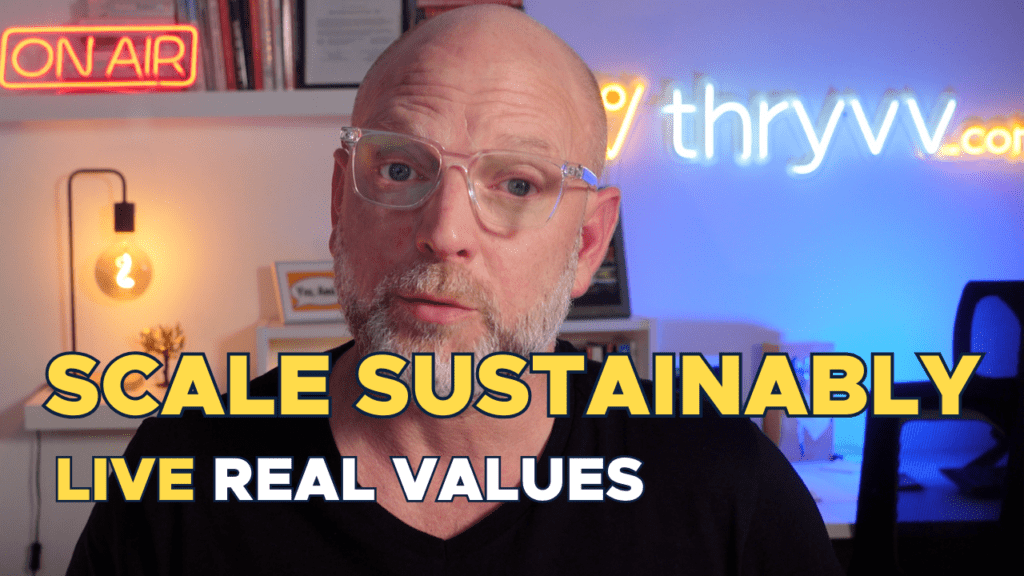
From Surviving to Thryvv-Ing
Imagine a company where every decision and action is a ripple stemming from the core ethos of its founders and or the unique culture that is its very essence. This isn’t a utopian dream but a tangible reality for businesses that embody their core values. Such companies aren’t just surviving; they thrive, even amidst market turmoil.
|“Everyone needs to know where you are going and how you’ll get there.”|
This article is about the “how you’ll get there”. I like to use the definition of operationalized values as:
“The actions that we take when we are at our best heading towards our purpose.”
I’m paraphrasing Simon Sinek, who, although some would say he is full of fluff, (1) as our industry, has been doing the work that he espouses for many years; I love the way that he communicates it, and he has had such a huge impact on awareness of our work. We at Thryvv also incorporated into our process on (re)-discovering and codifying the intrinsic values and purpose, his co-authored (with extremely experienced facilitators) book – “Now discover your why”.

“46% of job seekers cite company culture as very important when choosing to apply to a company.”
Thinking "They will just get it"- You are wrong!!
If you think that people “just get it” or that having the values on your website or on signs decorating the office is enough – then you are wrong!
Many CEOs proudly display their values, yet the corridors echo tales of disconnection. MIT Sloane researchers questioned the significance of a company’s espoused values—the ones they broadcast on their website or through communications. They discovered a complete lack of correlation between a company’s proclaimed values and cultural behaviour.
Consider these values: Communication, Respect, Integrity, and Excellence. Familiar, aren’t they? It may echo your company’s values, or certainly, they seem familiar to various corporations. Yet, these were the values Enron prove to be completely irrelevant.
Embedding values is the most resisted, maybe intimidating, among the six steps to creating a thriving team culture that leads to sustainable results in scaling tech and digital companies. But to demonstrate you are investing in, and achieving enduring growth—what your investors are eager to see—you must overcome your limiting beliefs and get curious.
If you are thinking – here we go, another coach who doesn’t understand the need for control or commercial pressures.
I get it; I was a billion-dollar regional CFO, avoiding waste and driving ROI, hitting the (often spuriously high) growth targets felt like life and death. I’ve been in leadership in the fastest growing tech company on the planet. The levels of stress I experienced for decades were certainly more than humans are designed to bear.
More so later in Sales Leadership, I was responsible for teams in the hundreds and personally had to pry purchase orders from the hands of some of the most cunning clients. I’ve screamed and bullied and pushed and driven until I got the results I needed to feel protected. I take responsibility for the toxicity that I created and manifested around me, as painful as that is. The journey from initial self awareness, to development and learning, made me who I am today. I have experienced very personally both sides, in depth. Pushing works. But be clear. Only, in the short term!
|”Culture is a 10X more powerful predictor of losing people and failing to attract them, than pay!”(4)|
The ground-breaking research of Bob Anderson and Bill Adams in “Mastering Leadership” and their Leadership Circle Profile, demonstrates concretely the statistical correlation between conscious values-based, purpose-led leadership effectiveness and profitability in the long term. Yes profitability! And to quote Bill, Creator of the first fully integrated Universal Model of Leadership, The Leadership Circle & 5 x Author and Advisor to Fortune 500 companies:
|”…..all (leadership Development) consultants and coaches…..listen and learn from Damian.”|
Failing to formalise values can lead to a scattered culture and inconsistent practices, making it difficult to maintain the entrepreneurial spirit in a growing company. As new members join, the essence of your culture might get diluted without a formalised set of values to unify and guide them.
Worse than that, if you are worried about struggling to retain and attract the best people as you scale, the facts speak for themselves: (1)
- 46% of job seekers cite company culture as very important when choosing to apply to a company.
- 91% of managers in the U.S. say a candidate’s alignment with the company culture is equal to or more important than skills and experience.
- 15% of job seekers turned down a job offer because of the company’s culture.
Okay- It sounds nice but what about in the Real World?
The true power resides not in proclaimed values but in the lived experience. Companies like Boost (A New Zealand-based software company) serve as a testament, transforming values into daily actions. They are not mere words; they are the pulse of every task and decision.

|”A values-driven workforce is four times more likely to be engaged, and engaged employees are 20% more productive.”|
A values-driven workforce is four times more likely to be engaged, and engaged employees are 20% more productive. (2) Now, consider this against the backdrop where 85% of employees are disengaged. (3) Being an organisation known for actualising its values becomes a lighthouse, attracting and retaining the right talent.
Values instill flexibility and informality by nurturing an environment where trust and autonomy are paramount. When a company’s culture is deeply anchored in strong, shared values, employees feel empowered to make decisions that resonate with these principles. This reduces the need for stringent formalities and hierarchies, as team members are entrusted to act in the best interest of the company’s objectives and the vision of its founders/CEO, fostering a more agile and adaptive organisation.
In a recent conversation with Pippa Clark, MD of ESM & Hamilton Aquatics, a leading sports management and elite training company, who has been my client for many years, I gained further reinforcement of the vital role of values within a rapidly expanding business. Pippa highlighted the organic evolution of values from the company’s founder. Yet, as the business scaled, the need to explicitly define and communicate these values became paramount to ensure that new hires were aligned with the company ethos.
Pippa emphasized the integration of these values into the very fabric of the recruitment and onboarding processes. A culture of recognition was fostered where employees’ actions that exemplified company values were celebrated, thereby reinforcing the behaviors that contribute to the company’s identity. This approach has yielded tangible results, such as improved staff retention rates, proving that a steadfast commitment to values can indeed enhance the bottom line.
- 47% of active job seekers cite company culture as their driving reason for looking for work.
- The fully loaded cost of staff turnover is up to 2X annual salary.(3)
The journey of maintaining a values-driven culture in a scaling company is fraught with challenges. ESM & Hamilton Aquatics tackle this through consistent, face-to-face interactions, ensuring values remain at the forefront of every decision.
So, what’s the difference between Pippa’s values-based organisation and others that just talk about values? In my experience, the acid test is when short-term profit comes (as it will do) into tension with a value. Would you pass the test and demonstrate to your team that you live the values? Because people do what you do, not what you say!
A notable instance that Pippa shared, was the decision to retract a marketing campaign that, despite its financial promise, did not align with the company’s standards of respect. This bold move underscored the company leadership’s dedication to its values over short-term gains.
Pippa poignantly remarked, “It’s not just about living the values themselves, but also about being vigilant. If team members observe a lapse in these values and remain passive, their silence signifies complicity. Active engagement and accountability are the hallmarks of a truly values-driven culture.”
As I integrate Pippa’s experiences into our broader discussion on values, her insights offer a profound reminder of the vigilance required to preserve a culture’s integrity, especially during periods of growth.
But here’s the thing: this is not fluffy stuff. It is profitable along with the other 5 steps to creating a team that achieves results. For example, at Boost, one of the companies we are using as a case study, since leveraging its values (and purpose), has increased staff by 16% and increased Net Profitability by 53% and won a national “Team Gold Award” – these impacts align with anonymous survey results in which 100% of employees say that the organisation stays true to its values.
So what to do?
Begin with rediscovery, delving into your company’s authentic narratives, from its inception—capturing the spark that ignited the founder’s vision—to moments when a customer service agent felt immense pride in their work, to the impact on a family when a new employee received an early paycheck.
Through these genuine stories, identify actions that exemplify your company’s values and solidify them as your standard. Embed these practices into every facet of your business, from hiring to critical decision-making. Values should be palpable and observable in daily operations.
Employ a systematic approach for teams to embody values, creating a shared language and commitment to behaviours that resonate with those values.
This method shines in executive teams and adapts to various organisational sizes. The goal is to establish measurable and observable behaviours that reinforce your values, thereby nurturing trust, flexibility, positive informality, engagement, and robust team dynamics.
If you find reasons not to do this, you are not alone….
I often encounter reluctance from relatively inexperienced CEOs and founders who fear that codifying values might hinder adaptability or dampen the informal culture. Now lets be clear, this does not mean we are talking about leaders with a lack of talent, even genius, potential and success. It’s understandable during the transition from intimate teams to global expansion. The concern is valid: no one desires a millstone around their neck in the name of fashioning values.
|”Yet, values are not an anchor but a compass for a business.”|
If you assume ‘everyone will get it’ as you scale, prepare for a shock. I’ve seen first-hand; a multi-million-dollar decision being made covertly, far from the founders’ oversight. Silence prevailed because values had been diluted by growth. In the end, these behaviours led to a catastrophic decline in a huge tech titan.
Most of the hundreds of leaders we’ve coached began sceptically but ended up embracing the process and its outcomes. When they witness the spark in their team’s eyes as they truly internalise the values, it’s transformative.
Your values not only provide a foundation but also create a safe haven that fosters flexibility and ignites innovation—if innovation isn’t on your agenda, perhaps this article isn’t for you. A CEO who lives the company values can be trusted.
“Trust in the CEO him or herself is correlated with things like innovation outcomes, so for instance, the level of trust in the CEO predicts the number of patents that company files.” To be more specific, digging into the research:
Having normalised for all other variables you can think of, a one standard deviation increase in the level of trust in the CEO leads to a 6% increase in the number of patents filed by a company.
One CEO client of Thryvv, who we’ve also worked with for over three years, shared:
|”The process had enlightened us about our values, which were always present but became potent when deliberately embraced. As long as we uphold these values, no matter how large our team grows, we will thrive.”|
‘It’s too complex, too time-consuming,’ some say. But the alternative is a culture adrift. The decision is clear—cultivate the roots or falter in adversity. To echo a CEO I worked with, “Can you afford not to?”
Why you need to get over your fears
Values are the invisible architects shaping measurable business outcomes: engagement, productivity, retention. They’re the unsung heroes in the fast-paced world of scaling businesses.
While unseen, values are the stewards of concrete results. They bolster employee engagement, fuel productivity, and are vital for retention. They serve as a gravitational pull that aligns actions with strategic goals, enabling even the most sprawling companies to maintain coherence and integrity.
As startups scale internationally, maintaining a cohesive culture becomes increasingly challenging. In a recent discussion, Amed co-founder of a successful Arabian-based tech startup, shared his journey grappling with this issue.
“We realised we needed to codify our culture before stepping back from daily roles,” said Amed. However, he feared that formalising values could expose conflicts between the co-founders or limit their flexibility in the future.
Amed recognised both “opportunities and risks” in writing down the implicit values. It could strengthen alignment as new leaders emerge, yet there was a fear that it would also threaten the founders’ control. He wished to sustain the “entrepreneurial spirit” that had driven past success while equipping distributed teams.
Through exploring potential solutions, Amed gained clarity on stakeholders’ needs. “Capturing informal values through employee storytelling could build engagement authentically,” he said. Consciously and collaboratively designed protocols addressing conflicts across regions aimed to scale the support values given.
Amed’s perspective highlights the delicate balance required as startups mature. Values provide cultural ballast during growth, but how they are operationalised must evolve organically to remain meaningful. With care and participation, formalisation can reinforce rather than replace a founding vision, empowering companies to scale while caring for their roots. Thoughtful leaders like Amed, supported by experts, ensure cultural continuity powers future impact.
Okay you got me - But What To Do?
The potency of values lies in their authenticity and their integration into the company’s pulse. Consider Boost, for example—a company from New Zealand where values are not just displayed but enacted daily. They’ve cultivated an award-winning culture by ensuring their values are not only espoused but also practiced.
In a workplace where potential high calibre recruits required to take your business to a next level are a click away, from getting a picture of your culture on, for example, glass door, or often by talking directly to past or current staff. It’s a small world in tech/digital, especially in Dubai, where we are based and of course in all other tech hubs. One high calibre Googler looking to transition and carefully combing through potential opportunities said to me the other day, “It’s not a small world – it’s a village”.
Three Steps To Leveraging Values To Facilitate Flexibility And Growth.
1. RECRUITMENT
Incorporate values into the recruitment process:
Hiring only those who align with them and utilising this as a chance to showcase them.
I recall a leadership team newcomer at one of our client companies expressing that, within two interview questions, he discerned the organisation’s commitment to values and knew he wanted to be part of it. In a sector like tech, where talent is constantly courted, such a stance is revolutionary in attracting and keeping top talent.
Prioritise Alignment with Company Purpose and Values:
Target recruitment efforts towards individuals whose personal values align with those of the company.
Design interview questions to uncover the candidates’ intrinsic values, particularly what they seek and prioritize in their professional roles and interpersonal work relationships.
Demonstrate Company Values Through the Recruitment Process:
Design the process to demonstrate concretely your values; for example, if you have a value of ‘Responsibility”, involve the broader team in the recruitment process to showcase the value; this can include their participation in interviews and the administration of technical challenges.
Again, for example, the value of “Care” by taking special care of candidates during their ‘meet-the-team’ day at Boost and pairing recruits with experienced employees as buddies throughout the onboarding process.
2. USE VALUES AS A STRUCTURE FOR EVALUATING DECISIONS.
Every choice, from the pinnacle of ethical judgement to the depths of ethical breaches, is rooted in a value-laden foundation. Decisions are an interplay of values, often requiring a nuanced balancing act between them.
The true values guiding our decisions frequently remain obscured due to our tendency to rely on cognitive shortcuts. It’s crucial to develop a method to uncover these underlying values, allowing for a deliberate contemplation of the values being weighed against one another.
“The fundamental work of Nobel Laureates Daniel Kahneman and Amos Tversky has inspired numerous studies on the cognitive pitfalls that skew human decision-making. A key issue in decisions that are often regretted is the lack of a holistic approach that weighs the trade-offs between conflicting values.
Moreover, in an era where organisations strive to foster values-centric decision-making cultures, the structural complexity and layers of hierarchy within them can create a disconnect. Decisions made at the grassroots of management might stray from the strategic direction set by the upper echelons, inadvertently shaping or even countering the company’s core values and strategic goals.
Traditional corporate strategies tend to hammer in the importance of values and codes of conduct. However, these alone can become mere totems, more emblematic than functional, influencing daily choices less than intended. Contemporary studies echo this sentiment, indicating that such measures tend to be more ceremonial than effective.
The remedy lies in integrating values education within the decision-making process. It’s essential to peel back the layers to reveal the values influencing these decisions. Our framework is crafted to simplify the decision-dissection process, enabling individuals to pinpoint and deliberate the trade-offs between competing values.
3. SEARCH OUT AND MAKE IT NORMAL TO RECOGNISE VALUES IN ACTION.
|”79% of employees say they would be more loyal to their employers if they received more recognition.”|
A Values Awards Ceremony is a cornerstone tradition designed to celebrate and recognize team members who exemplify your core values. A monthly event that not only honours outstanding behaviour but also reinforces the principles that define our company culture. The ceremony serves as a practical demonstration of our values in action and strengthens team cohesion by highlighting how our colleagues live out these ideals daily. The participatory nature of the event, where previous winners select the new awardees, ensures that the values remain a living, evolving part of our everyday experience.
Action Steps for the Values Awards Ceremony
Step one: Organize a monthly team meeting dedicated to the Values Awards ceremony.
Step two: Honor the Individuals: Acknowledge four team members during the ceremony, each of whom has been chosen for their exemplary demonstration of one of our core values.
Step Three: Presentation of Awards: Present each honoree with a token that symbolizes the value they represent, detailing the actions that merited this recognition.
Step Four: Clarify and Embed Values: Use the opportunity to clarify the practical application of our values and how they integrate into our work routine.
Step Five: Foster Team Unity: Encourage team bonding by reflecting on how the awardees’ actions embody the collective values, thereby strengthening the company’s ethos.
Step Six: Engage in Selection Process: Involve the current awardees in choosing the subsequent recipients, prompting them to reflect and converse on the values’ impact, which enhances their significance and authenticity.
Imagine A Future With Growth & Flexibility
So, to CEOs on the verge of greatness, I extend an invitation to strengthen your company’s core. It’s a call to evolve from ‘value-stating’ to ‘value-living’—and witness a culture that not only endures but also accelerates growth through flexibility.
(1)Forbes.com “Simon Sinek is full of fluff and other reasons you should follow his lead”
(2)Builtin.com “42 Shocking Company Culture Statistics You Need to Know”
(3)MIT Sloan – Sull & Sull – “Why every leader needs to worry about toxic culture”
(4)Gallup State of the Global Workplace: 2023 Report
Note: Some of the names may have been changed to honour confidentiality.
